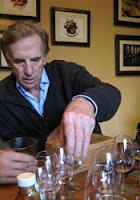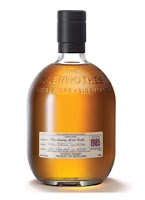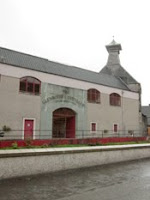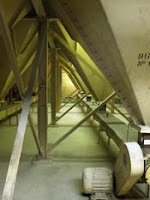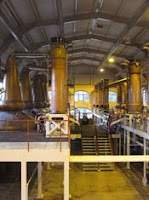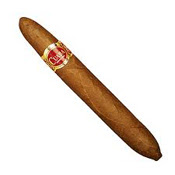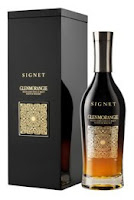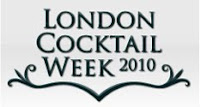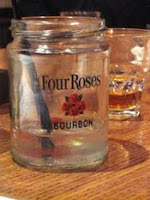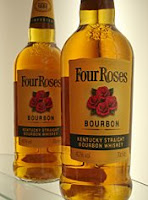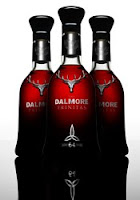 Diageo, the world's leading premium drinks company, have just released their latest cask strength single malt whisky range. The Special Release series began in 2001 and the selected bottlings are released annually, around this time of the year. The idea is to showcase special stock that they are holding from their existing and closed Scottish distilleries. This years selection is made up of nine single malt scotch whiskies, with all limited in numbers and are highly collectable and desirable as a result. They will only be able to be purchased from specialist retailers and in selected markets around the world.
Diageo, the world's leading premium drinks company, have just released their latest cask strength single malt whisky range. The Special Release series began in 2001 and the selected bottlings are released annually, around this time of the year. The idea is to showcase special stock that they are holding from their existing and closed Scottish distilleries. This years selection is made up of nine single malt scotch whiskies, with all limited in numbers and are highly collectable and desirable as a result. They will only be able to be purchased from specialist retailers and in selected markets around the world.We at Whisky For Everyone were lucky enough to get an invite to the official launch and tasting of the Special Releases that was recently held at Diageo's headquarters in London. We will present our tasting notes from the evening in two parts. To read the first part, including the Auchroisk 20 years old, Brora 30 years old, Glen Spey 21 years old and Talisker 30 years old - click here.
___________________________________________________________
 Caol Ila 12 years old Unpeated
Caol Ila 12 years old UnpeatedInfo > 57.6% ABV - 6000 bottles - Matured in ex-bourbon casks - RRP £52
The Caol Ila distillery (pronounced cowl-ee-la) is located on the north eastern shores of Islay, the famous whisky island off Scotland's west coast. Islay is well known for producing the peaty, smoky style of whisky and Caol Ila is no exception. Well, except this bottling! Caol Ila produce an unpeated non-smoky spirit for roughly two weeks a year and release this in limited batches. Caol Ila was founded in 1846 and is the largest distillery on Islay, producing 5.8 million litres per year.
The colour is pale gold and the nose is fresh and vibrant. There are notes of vanilla, toffee and malty cereal grains (think of oatcakes), with the freshness coming from a combination of aromas, including salty brine, citrus zest, something floral (imagine honeysuckle) and a whiff of surgical spirit or bandages. The palate is light and zingy with the fresh notes from the nose appearing first, especially the zest and the honeysuckle. Then the saltiness comes, followed by the vanilla, toffee and cereal characters. Some additional green apple and a chalky, almost mineral note finish things off. Upon adding water, the whisky becomes creamier and more buttery in the mouth and some of the zingy, zesty notes are lost. The finish is clean and refreshing with that warming, medicinal touch of surgical spirit putting in a pleasant return towards the end.
 Cragganmore 21 years old
Cragganmore 21 years oldInfo > 56% ABV - 6000 bottles - Matured in ex-bourbon refill casks - RRP £135
Cragganmore is a distillery which is located in the heart of the Speyside region, close to the village of Ballindalloch. It was founded in 1869 and has a current production capacity of 2 million litres. Cragganmore has long been the Speyside representative in Diageo's Classic Malts - a range in which they have selected their definitive whisky from each region of Scotland. Despite this, Cragganmore is one of the least known single malts in the range. Sales are growing and a decent majority of whisky also goes in to blends, such as Old Parr and White Horse. Older expressions, such as this one, are rare.
The colour is a rich gold and the nose is packed with vanilla and oak. Added to this are notes of nuts (think of coconut and toasted almonds), malty cereals, shortbread biscuits, honey and a whiff of spice (imagine cinnamon bark). The palate is rich and tangy, with a lovely freshness. There are immediate notes of wood spices like cedarwood and cinnamon, more vanilla, honey, buttery biscuits (probably that shortbread again), oats and some fiery ginger. There is also a sharp tang of citrus (especially lemon) and further woody notes that dry the sweetness out and are reminiscent of wood shavings. The finish is warming, is of decent length and is a little bittersweet. It begins with honey and vanilla, before the wood and spice notes pile in to give a rasping, fiery ending.
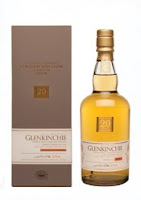 Glenkinchie 20 years old
Glenkinchie 20 years oldInfo > 55.1% ABV - 6000 bottles - Matured in ex-bourbon refill casks - RRP £125
Glenkinchie, like Cragganmore, is one of Diageo's Classic Malts, this time representing the Lowlands region in the range. The distillery is located in the town of Pencaitland, which is a short drive from Edinburgh and makes it a popular spot for tourists. It was founded in 1837 and has a current production capacity of 2.3 million litres per year. The popularity of Glenkinchie's single malts are rowing as a result and older versions, such as this, are rare so we were looking forward to sampling it.
The colour is pale yellow gold and the nose is initially sharp, fresh and clean. With time, this settles down to reveal a highly perfumed and slightly unusual nose - it is a mix of floral notes (think of rose petals and honeysuckle) and tropical fruits (imagine mango and peach). These are joined by more traditional ex-bourbon cask aromas of vanilla, honey and oak, with a distinct grainy note also coming through. On the palate, it is again fresh with the floral and tropical notes present, along with some fresh green fruits (pear and apple especially). The vanilla, honey and oak notes combine with coconut and cereals well. The addition of water brings out the cereal character further and a dried grass herbal note appears to add dryness. The finish is short and sweet, getting drier towards the end.
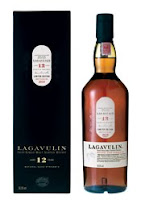 Lagavulin 12 years old
Lagavulin 12 years oldInfo > 56.5% ABV - Limited quantity of bottles, no exact figure released - Matured in ex-bourbon refill casks - RRP £59
Lagavulin (pronounce laga-voo-lin) is located on the south eastern corner of the famous whisky island of Islay. It is one of the most highly regarded distilleries for the production of the heavily peated, smoky style of whisky. The distillery was founded in 1816 and has a current annual production capacity of 2.2 million litres. Lagavulin single malts are highly sought after and it is the Islay representative in the Classic Malts series. It is occasionally used in blending, especially in the popular White Horse.
The colour is a light gold and the nose hits you in the face with a complex mix of aromas - toffee, burnt sugar, vanilla, malty cereals, a hint of salty brine, earthy smoke (think of damp moss and wet soil), honey and a whiff of parma violet sweets (those purple hard sweets that you had as a child). The palate is equally as complex and initially very sweet, with the honey and vanilla to the fore. Then comes an interesting fruitiness that is reminiscent of plums, and a hint of zingy lemon zest. Finally comes a touch of salt and that famous Lagavulin smokiness, which is more ashy and bonfire-like than on the nose. The finish goes on for ages with notes of burnt sugar and cereals mixing with the increasing peat smoke and a dash of bitter iodine.
 Port Ellen 31 years old
Port Ellen 31 years oldInfo > 54.6% ABV - 3000 bottles - Matured in both ex-bourbon and ex-sherry casks - RRP £250
The Port Ellen distillery has been closed since 1983, making its whisky very rare and highly desirable. Diageo currently limit the release to this annual Special Release and as a result the price is high and they sell quickly. Releases through independent bottlers are more common but still limited and pricey. The distillery was located on the island of Islay and was founded in 1825. The floor maltings are still used to produce much of the island's peaty malted barley, but the distillery has laid dormant since it closed.
This whisky is amber in colour and the nose is surprisingly fresh and lively for something of this age. The smoke immediately hits and is woody and ash-like in nature. Then other aromas start to appear - sweet caramel, cereal husks, shortbread biscuits, some waxy furniture polish, vanilla and a whiff of salty sea air. The smokiness gets a medicinal antiseptic quality with time. On the palate, there is initial honey and caramel sweetness, with more coming from the vanilla and distinct cereal notes. The smokiness creates a bitter edge, almost acrid, and is distinctly ashy and reminiscent of burning embers. The finish is long and smoky, becoming more antiseptic and bitter with time. Vanilla, some burnt caramel and a herbal note (think of dried grass) mix with a pleasant saltiness to create a complex and enjoyable dram.
This year's Special Releases selection is very consistent across the board. All of the whiskies are good and the selection covers all the different styles and flavour profiles. They have chosen whiskies from well known and popular distilleries and mingled these with rare and lesser known ones. Our personal favourites are > Karen - Glenkinchie 2o years old, Matt - Talisker 30 years old.








